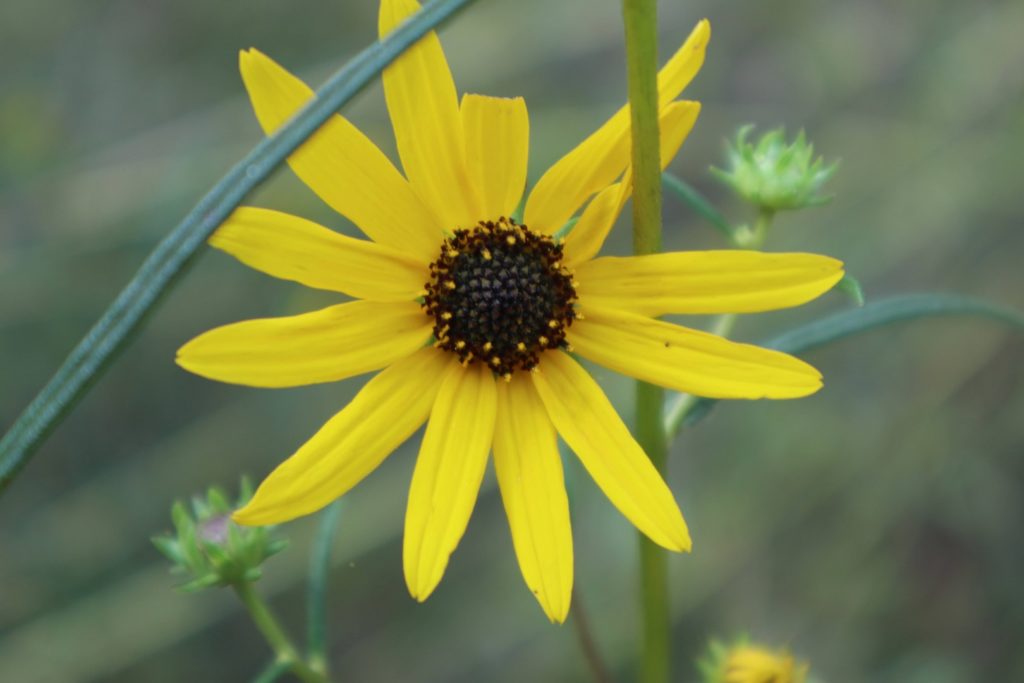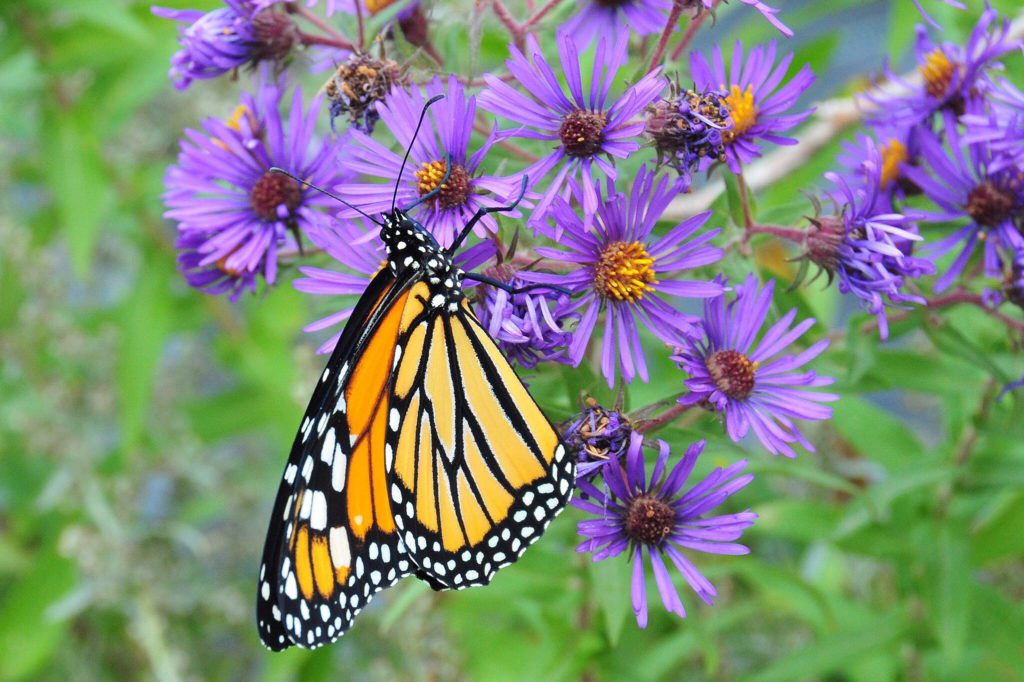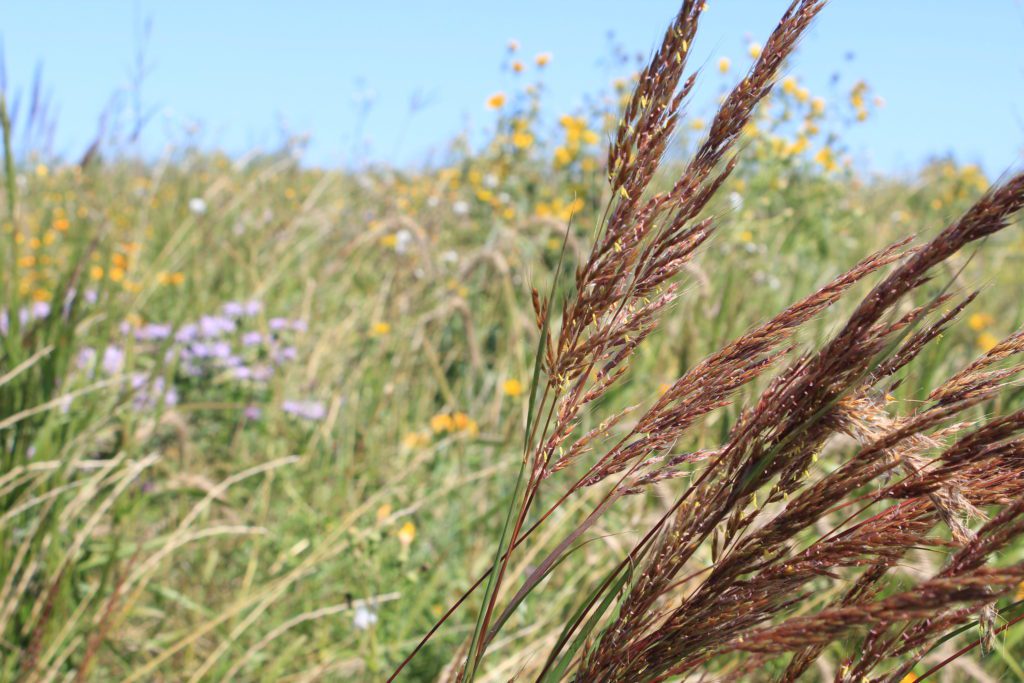Autumn, like spring, is the perfect time to drop your plants! Unlike summer, when new plants need watering to settle in for the season, nature does much of the watering, with rain, in the milder seasons.
Perennials planted in the fall will overwinter and come back stronger and more established the following spring.
All of this makes autumn a great time to dig and plant a rain garden, which will protect your home from flooding in the early spring thaw. For more information on how to build and design your very own rain garden, check out our self-directed Rain Garden Master Class, available online!
In the meantime, check out some of our favourite fall blooms below:
Mistflower (hardy ageratum)
Conoclinium coelestinum (syn. Eupatorium coelestinum)

Range: Native to eastern North America.
Season: Misty blue or pastel-purple flowers fuzzily bloom from September to October.
Type: This perennial herbaceous forb can grow up to 3’ tall and 2’ wide. Hardy down to -25°C.
Sun: Prefers full sun in moist conditions, tolerates partial shade in drier conditions.
Soil: Prefers moist soil, but drought tolerant when established. Tolerates alkaline pH and claggy clay.
Relationships: Attracts bees and butterflies. Deer and rabbit resistant due to high alkaloid content.
Uses: Cut-flowers, dried flowers, mass-planting, ground-cover, butterfly gardens, and in rain gardens.
Fun Facts:
A good substitute for annual ageratum. Can dominate gardens when it thrives. Important late-season nectar-plant for migrating pollinators. Lacks ray-florets that are present, more typical, and iconic of the aster family (like in sunflowers).
Swamp Sunflower (Mountain Daisy)
Helianthus angustifolius

Range: Native to floodplains, wet meadows, and savannahs of eastern North America.
Season: Bright blooms of yellow form from October until November frost.
Type: Perennial forb growing from 5-7’, even 10’ tall. Hardy down to -33°C.
Sun: Prefers full sun but tolerates partial shade.
Soil: Prefers moist acidic soils but can tolerate short periods of drought and some salt after establishing.
Relationships: Deer-and-rabbit-resistant. Adored by the American goldfinch for its nutritive seeds. Nectar and pollen support pollinators. Larval host to many native butterflies.
Uses: Butterfly gardening, rain gardens, bird gardens.
Fun Facts:
A late-season saviour for migrating butterflies. Seed-heads persist into winter to feed overwintering seed-eating songbirds. Flood-resistant. Low-maintenance. Can be planted with black walnut trees.
New England Aster
Symphyotrichum novae-angliae (syn. Aster novae-angliae)

Range: Native to moist meadows, prairies, and woodlands of eastern North America.
Season: Purple flowers appear alongside goldenrods from August to October.
Type: Perennial forb with 3-6’ height and 2-3′ width. Hardy down to -40°C.
Sun: Thrives in full sun but will find a way to survive with partial shade.
Soil: Prefers moist to wet soils; tolerates drought but becomes raggedy if severe and prolonged.
Relationships: Deer and rabbit resistant. Attracts butterflies, like migrating monarchs.
Uses:
Cut-flowers, cottage gardens, butterfly gardening, pollinator garden, rain gardens, landscape restoration.
Fun Facts:
It likes its personal space for ample breathing room to prevent problems with powdery mildew. Low-maintenance. ‘Purple Dome’ cultivar is a more compact alternative. Used medicinally in Iroquoian and Algonquian cultures, appearing in texts as a remedy for rashes from poison ivy.
Kinnikinnick (common bearberry)
Arctostaphylos uva-ursi

Range: Native to circumpolar and alpine regions of the northern hemisphere.
Season:
Glossy dark-green leaves take on an autumn blush of vibrant vermilion. Pink to white bell-shaped flowers appear in the spring, and bright-red berries persist through the winter.
Type: An evergreen perennial dwarf shrub. Hardy down to -36°C.
Sun: Grows in full-sun to partial-shade.
Soil: Found in sandy or rocky well-draining substrate—tolerates poor soils.
Relationships: Attracts butterflies and hummingbirds. Berries support bears and birds.
Uses: Erosion-control on slopes. Ripe berries are edible. Used in traditional medicine. Great for groundcover.
Fun Facts:
Bears adore Kinnikinnick’s berries, hence their common and scientific names. Its native name in Algonquian languages means ‘mixture’ as it was often combined with tobacco, sumac, and other herbs in sacred smudges, ceremonial smoking, and incense. Related to manzanita. Low-maintenance.
Yellow Prairie Grass
Sorghastrum nutans

Range: Native to North American grasslands east of the Rockies and south of the arctic.
Season:
Grassy green mounds turn to tall fall foliage in a feathery harvest gold. Blooms with beautiful white florets from late summer to early autumn, before they turn a rusty amber.
Type: This perennial rhizomatous bunchgrass can grow to be 3-7 feet tall. Hardy down to -22°C.
Sun: Prefers full-sun.
Soil: Prefers dry to moist silty loam. Likes alkalinity, tolerates both seasonal drought and flooding.
Relationships:
A friend to grasshoppers and seed-eating birds. Provides cover and nesting habitat for birds. Larval host to certain skipper species. Nibbled and grazed by herbivores.
Uses: Erosion-control and habitat restoration.
Fun Facts:
Deep root system prevents soil loss and erosion. Fast-growing. Adapted to bison-grazing and grassfires. Stands tall and keeps your garden lively, even over the winter! One of the ‘Four Horsemen of the Prairies’.
Switchgrass
Panicum virgatum

Range: Native to North America, east of the Rockies and south of Hudson Bay.
Season: Sprouts in spring, flowers in summer, and provides seasonal interest through fall and winter.
Type: Compact, upright, 3-6′ tall perennial bunchgrass. Hardy down to -23°C.
Sun: Tolerates partial shade but prefers full sun.
Soil: Tolerant of drought and seasonal flooding.
Relationships:
Unaffected by black walnut (Juglans nigra). Deer-resistant. Preferred host of the pink-streak moth (Dargida rubripennis) and grass skippers. Creates cover and provides food for seed-eating birds.
Uses: Erosion-control and landscape restoration. Used as feedstock and biomass for energy production.
Fun Facts:
Comes in upland, coastal, and lowland ecotypes. Its fibrous root-system can extend deeper than it is tall, providing erosion-control and soil amendment, creating a rich and healthy topsoil layer. One of the ‘Four Horsemen of the Prairies’.
Big Bluestem (turkeyfoot)
Andropogon gerardii

Range: Native to the Great Plains and grasslands of central and eastern North America.
Season: Leaves take on an autumn blush of bronze.
Type: Perennial rhizomatous bunchgrass growing 5-8′ tall and 2-3′ in diameter. Hardy down to -23°C.
Sun: Prefers full sun, will survive under light shade.
Soil: Drought-tolerant. Tolerates seasonal flooding, clay, some salt, and alkalinity.
Relationships:
Larval host for skippers, butterflies, and beetles. Habitat for native ants. Seeds feed birds. Provides cover for birds and butterflies. Provide high-protein forage for deer and other wildlife.
Uses: Good for mass-planting. Feed for horses and cattle. Erosion-control.
Fun Facts:
Grows as a single neat and bushy bunch of busy grasses. Young leaves have purplish segments. Its green stems turn bluish as they mature, giving them one of their common names. Flower-stalk resembles a turkey’s foot, giving the plant its other common name. Fire-adapted. Widest range of all the prairie grasses, from the Rockies to the Atlantic coast and Hudson Bay into Mexico. Low-maintenance. Tallest of the ‘Four Horsemen of the Prairies’.
Little Bluestem (beardgrass)
Schizachyrium scoparium

Range: Native to the North American prairies, savannahs, grasslands, and dunes.
Season: Takes on an autumn blush of bronze and reddish amber.
Type: Perennial. Is a bunchgrass. 2-4′ tall with 2-3′ spread. Hardy down to -30°C.
Sun: Full-sun, shade-intolerant. Heat-tolerant.
Soil: Prefers well-drained soil on the drier side. Drought-tolerant. Intolerant to flood.
Relationships: Larval host to various native skipper butterflies. Seeds support songbirds.
Uses: Phytoremediation of soils contaminated by copper. Controls against wind-erosion of soil.
Fun Facts:
Great for adding autumn interest to your rain garden, and also lasts into winter. Adds a bright blue to your spring rain garden with young leaves and stems, giving the grass its common name. Root-ball can be divided in spring to create more plants. Its sibling, Dune Bluestem (S. littorale), is adapted to sand-dune habitats. One of the ‘Four Horsemen of the Prairies’. Low-maintenance.
Canada Wild Rye
Elymus canadensis

Range: Native and well-suited to prairies, dunes, savannahs, and open woodlands of North America.
Season: Leaves and seedheads turn a harvest gold in autumn.
Type: Perennial rhizomatous bunchgrass. 2-4′ tall with 1-2′ breadth. Hardy down to -41°C.
Sun: Full sun, shade intolerant.
Soil: Prefers average soil moisture.
Relationships: Host to several lepidopteran species. Seeds and foliage feed native fauna’s needs.
Uses: Used for erosion-control and remediating contaminated land reclaimed from metals mining.
Fun Facts:
Pendulous seed-heads resemble wheat and provide a unique look to your garden. Its cousin, Virginia Wild Rye (E. virginicus), is more tolerant of shade and increased moisture. Semi-evergreen.
Tufted Hairgrass (tussock grass)
Deschampsia caespitosa

Range: Native to all types of grasslands in North America but prefers cool coastal prairies.
Season: Feathery flowers in summer persist into autumn as airy seedheads.
Type: Perennial bunchgrass. Grows 2-4′ tall and 1-2′ wide. Hardy down to -38°C.
Sun: Prefers partly shaded to partly sunny exposures.
Soil: Prefers moist to wet soils. Flood tolerant. Drought intolerant.
Relationships:
Provides food and habitat for songbirds and shorebirds, as well as for landfowl, waterfowl and small mammals. Host plant for the umber skipper butterflies.
Uses: Flower arrangements (dried or otherwise), phytoremediation of land contaminated by metals.
Fun Facts:
A good native substitute for non-native lawn grasses. Low-maintenance.

Trackbacks/Pingbacks